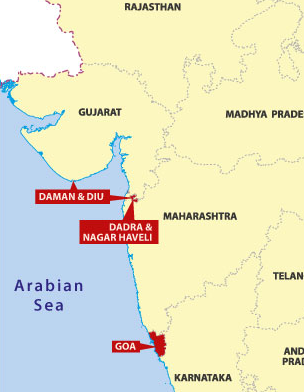Why in news?
The Dadra & Nagar Haveli and Daman & Diu (Merger of Union Territories) Bill, 2019 was recently introduced in the Lok Sabha.
What is the Bill on?
- The Bill aims at merging the two Union Territories of ‘Daman and Diu’ and ‘Dadra and Nagar Haveli’ into one.
- Both the UTs are located on India’s western coast near Gujarat.
- They were colonial possessions of Portugal before they became part of independent India.
- Dadra and Nagar Haveli has just one district while Daman and Diu has two.
- Daman and Diu are separated by the Gulf of Khambhat.
- The merger of the two UTs is said to be done for better administration and checking duplications of various work.

How did these territories come under Portuguese rule?
- Daman and Diu - Before the arrival of the Portuguese, both Daman and Diu were part of the Sultanate of Gujarat.
- Sultanate of Gujarat was an independent kingdom during the 15th and 16th centuries.
- It comprised the present-day Gujarat and neighbouring areas.
- Portuguese had arrived in India at the end of the 15th century, and were an energetic and ambitious maritime power at that time.
- Early in the 16th century, the Sultan of Gujarat, Bahadur Shah, came under immense pressure.
- His kingdom was invaded by the second Mughal Emperor Humayun.
- At that juncture, he decided to remain on conciliatory terms with the Portuguese.
- Thus, in 1534, the Shah signed the Treaty of Bassein with the Portuguese.
- By this, he ceded Diu to the latter, as well as other territories of his empire such as Vasai and the islands that today form Mumbai.
- The Portuguese obtained Daman from the Shah in 1559.
- Diu became an important port for the Portuguese, who built a large fortress there, as well as other buildings.
- Within a few years of acquiring the island, Gujarati ships using the port of Diu were required to pay duties to the Portuguese.
- For over four centuries, both Daman and Diu remained part of the Portuguese dominions in India, and were ruled from Goa.
- Dadra and Nagar Haveli - Nagar Haveli passed from its Rajput rulers to the Marathas in the mid-18th century.
- It was transferred to the Portuguese in 1783 as compensation for a ship that the Marathas had destroyed.
- The Portuguese then acquired Dadra in 1785.
What happened after India’s independence?
- After India’s independence from Britain, Portugal refused to hand over its territories in India.
- It was claimed to be an integral part of Portugal.
- On a diplomatic level, India tried to persuade Portugal to transfer its territories peacefully.
- Locally, Indian nationalists organised resistance against Portuguese occupation.
- In 1954, they were able to seize Dadra and Nagar Haveli, and an economic blockade was imposed over the rest of the Portuguese-held territories.
- The loss of Dadra and Nagar Haveli sent alarm bells ringing for the Portuguese.
- So, security was tightened in their remaining Indian possessions.
- Additional troops were brought in from Portugal, Angola, and Mozambique (the latter two were Portuguese colonies until 1975).
- Around 8,000 European, African, and Indian troops were split between the districts of Goa, Daman and Diu.
What was Operation Vijay?
- In December 1961, as attempts at conciliation failed, India launched Operation Vijay against Portuguese India.
- While most of the hostilities took place in Goa, the Daman and Diu territories also witnessed action.
- The IAF inflicted heavy damage, ultimately forcing the Portuguese to surrender.
What happened after the Portuguese left?
- Immediately in December 1961, Goa, Daman and Diu were constituted into the Union Territory of Goa, Daman and Diu.
- In 1967, a referendum called the ‘Goa Opinion Poll’ was held.
- Voters were asked to decide whether the UT should be merged with Maharashtra or should remain separate.
- The mandate was against a merger, and the UT continued as before.
- In 1987, Goa achieved statehood, and Daman and Diu became a separate UT.
- Between 1954 to 1961, Dadra and Nagar Haveli was administered by a citizen’s council called the Varishta Panchayat of Free Dadra and Nagar Haveli.
- In 1961, it became a Union Territory.
Source: Indian Express
